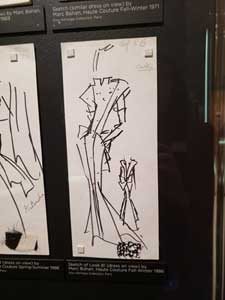 On a beautiful, sunny day in January, the Colorado Springs ASG garment group toured the Dior exhibition held at the Denver Art Museum. I had heard glowing reviews from other friends who had attended, but I was not prepared for the scope of the offering. A selection of more than 200 couture dresses was on display, along with many drawings, mood boards and accessories. The exhibition was even more fantastic because of the way the garments were presented, having been designed by the internationally renowned architect Shohei Shigematsu.
On a beautiful, sunny day in January, the Colorado Springs ASG garment group toured the Dior exhibition held at the Denver Art Museum. I had heard glowing reviews from other friends who had attended, but I was not prepared for the scope of the offering. A selection of more than 200 couture dresses was on display, along with many drawings, mood boards and accessories. The exhibition was even more fantastic because of the way the garments were presented, having been designed by the internationally renowned architect Shohei Shigematsu.
The first room of the exhibition had the viewers walking through a dimly-lit passage filled with toiles made up in a flat black fabric (even the mannequins were black). Something about stripping the designs of all color allowed the viewer to see the beautiful structure of the garments.
We were able to see design boards and garments by Christian Dior, who was head of the house for a short time before his death. The exhibition then showed garments and their inspiration from all the lead designers who have followed, including Yves St. Laurent. Each of these designers has contributed his or her own design esthetic to the Dior line.
Another striking room was filled with traditional toiles in white. The room was probably 25 feet tall and the toiles were hung on the wall at least four garments high. We were told that Dior drew his sketches without a lot of thought as to how they were going to be constructed. He expected his workers to be able to translate his designs to finished garments, the toile being the first step.
One room of about 20 ball gowns featured a video display above with images of celebrities in some of the same gowns. While we definitely couldn’t touch the garments, we were able to get quite close to some of them.
Part of Dior’s genius was to design and create accessories, even perfume, so that a woman could be clothed head to toe in Dior. One display had colorful columns that held hats, headpieces, jewelry, shoes, bags and what looked like doll clothes. It was a bold presentation that captured the breadth of the line.
In many cases, the designers of the House of Dior were influenced by what was happening in the greater art world. This influence showed up in fabric creation and garment silhouettes. In many rooms the Denver Art Museum showcased actual art that served as inspiration.
The final room of the exhibition was an extensive display of Dior around the world. The room was enormous with the garments standing on tiered discs. With almost 50 garments, the visual punch was intense.
We all agreed that once through this exhibition was not enough to take it all in. Perhaps we’ll be able to go again before it leaves Denver and makes its way to Dallas – the only two cities in the US to house the exhibition.
~Thank you to Cecelia Harris from the Colorado Springs chapter for this post.





